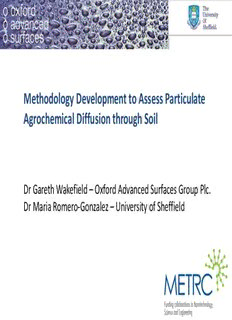
OAS and Sheffield presentation - N8 Research Partnership PDF
Preview OAS and Sheffield presentation - N8 Research Partnership
Methodology Development to Assess Particulate Agrochemical Diffusion through Soil Dr Gareth Wakefield – Oxford Advanced Surfaces Group Plc. Dr Maria Romero-Gonzalez – University of Sheffield OAS - About Us Begbroke Science Park – 5 miles north of Oxford. Mixed Department of Materials/Commercial site Currently 19 employees OAS - About Us • We develop novel materials & license IP / know-how – global customers can exploit this to develop new products in next generation materials & products • Target high-value/high-growth markets in electronics, green energy and eyewear in two core technologies – Onto™ patented highly reactive chemistry – VISARC™ anti-reflective optical coatings utilising OAS MPS particles • Formed in 2006 – spin-out of Oxford University – Listed on AIM UK Stock market (OXA) – ISO 9001:2008 certificated 3 www.oxfordsurfaces.com Core technologies OntoTM reactive Chemistry • Developed at Oxford University over 10 years • Uniquely reacts with everything • The power to toughen any material, to adhere to any surface, to make one chemical surface resemble another....... • Enabling 21st century products Nanosized Optical Films • Transparent surface films 1/1000 thinner than a human hair • Change the way light passes through surfaces • The power to stop glass reflecting, to increase solar cell efficiency, to make lap top screens readable outside........ Technical Challenge From: Köhne JM, ‘A review of model applications for structured soils: Pesticide transport, Journal of Contaminant Hydrology 104 (2009) 36-60 Up to 90% of herbicide never reaches objective Herbicide Market 2011: Tonnes 1,080k Value $18,600M 2016: Tonnes 1,351k Value $24,821M Up to 90% of herbicide never reaches objective METRC project overview OAS approached by OAS can coat particles – but agrochem Sheffield Group has wide no experience in agrochem company – can we coat experience of soil chemistry or soil transport herbicides? OAS Collaborator • Supply herbicide and formulated control herbicide OAS • Coat herbicide and run simple quartz assays University of Sheffield • Develop quartz and soil assays • Run initial greenhouse trials Technical Challenge Herbicide particle must: The ‘collector 1: Hit soil particle (collector) efficiency’ Mechanism of attachment > 2: Stick to soil particle shear flow release Coating allows 3: Release herbicide herbicide dissolution at normal rate Transport of particle through a saturated porous media Herbicide particle comes into contact with collector (soil model- quartz) by: • Interception – Particle moving along streamline hits collector • Sedimentation – Gravitational settling of particles on to collector • Brownian motion – Can result in collector contact Single collector contact efficiency, = + + 0 D l G Where = transport by diffusion D = transport by interception l = transport by gravitation G See M. Tufenkji and M. Elimelech, Environ. Sci. Tech., 38 (529-536) 2004 Attachment of herbicide particles to collector particles Total energy of interaction, G, is given by: Electrostatic interaction y = Distance between collector and particle Zeta potential, k = reciprocal Debye length 1.Herbicide -89mV 2. Quartz -25mV Zeta potential is key for increasing electrostatic interaction
Description: